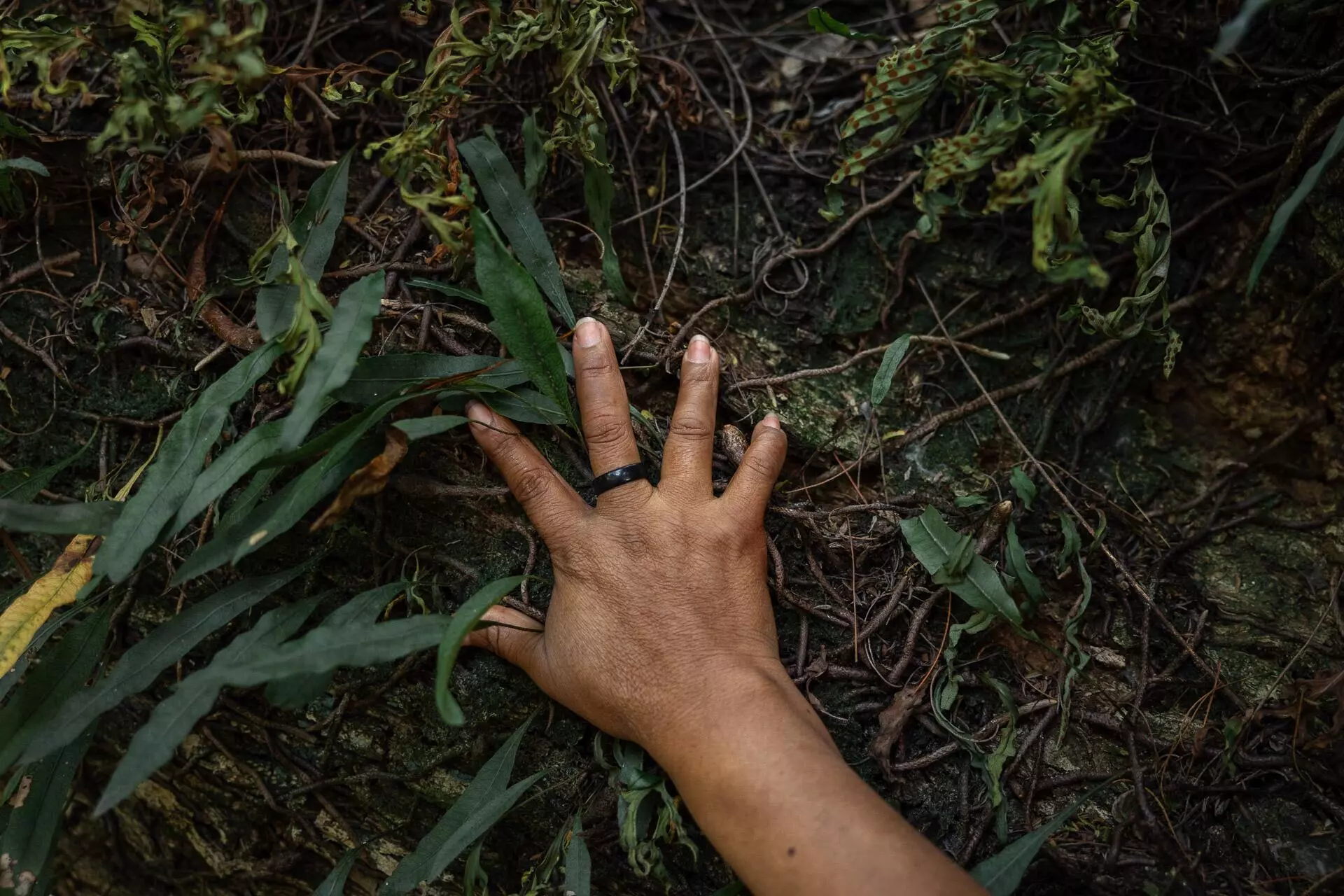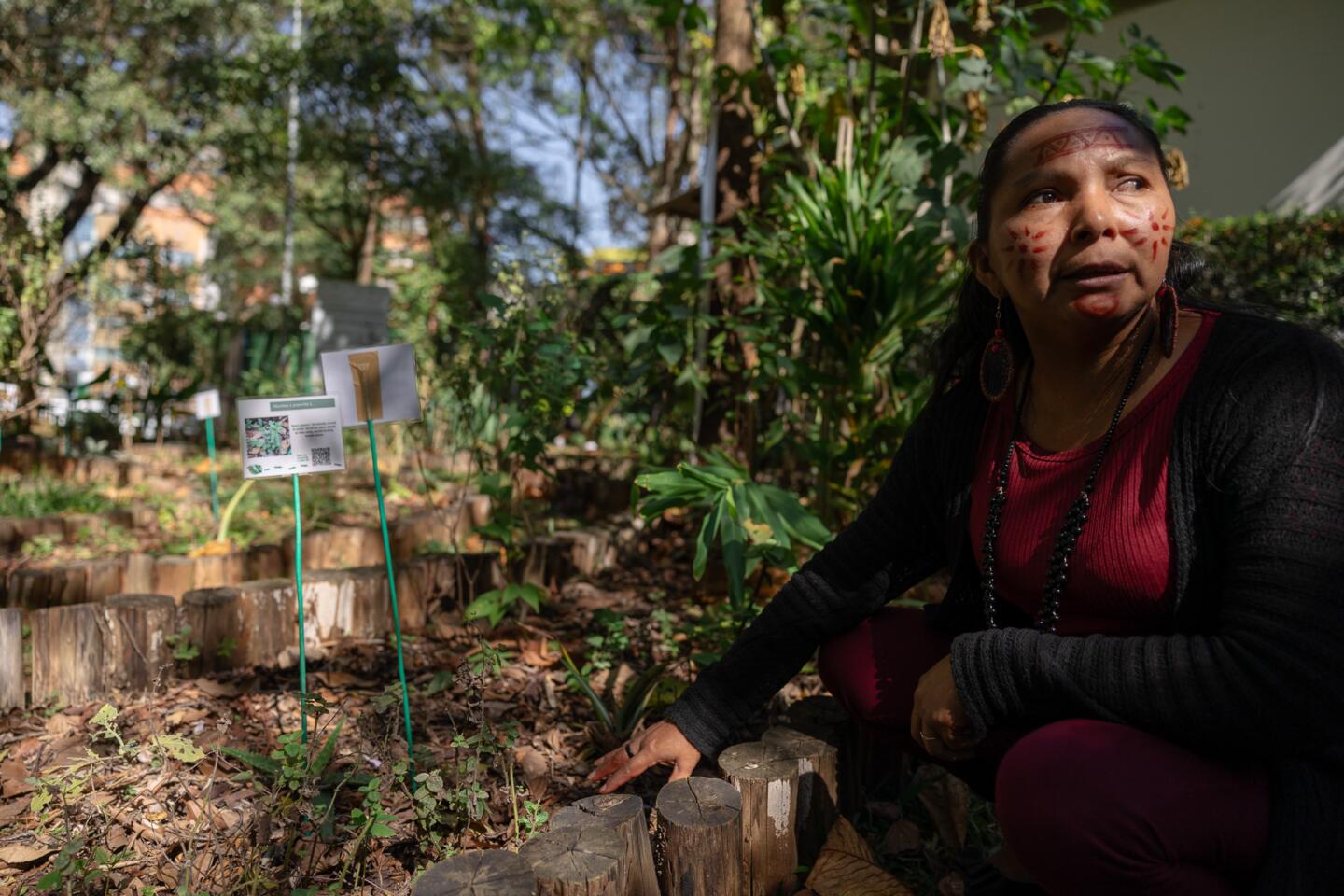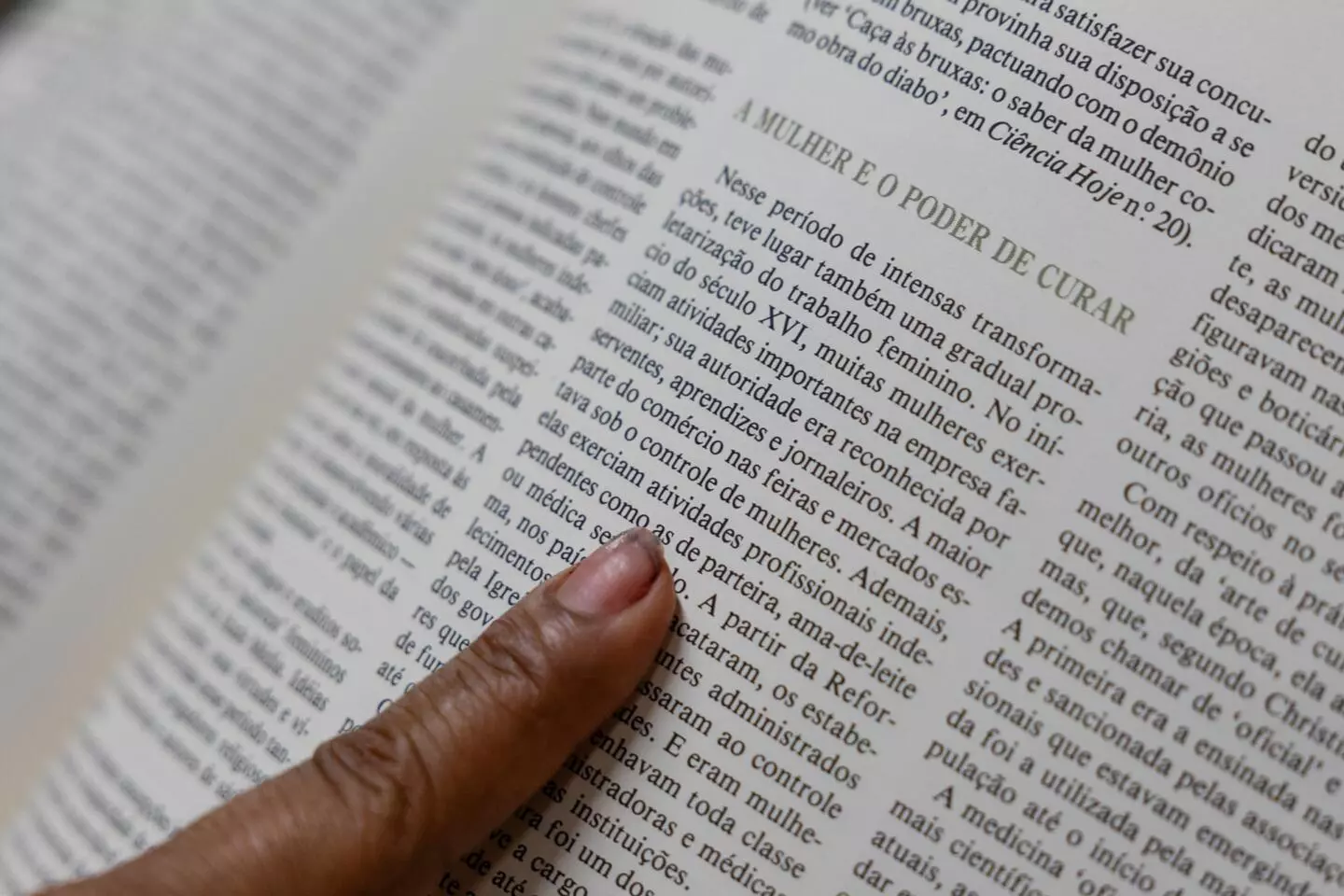Can a garden heal the wounds of loneliness?
By Malu Delgado*
Our conversation is preceded by a ritual. To get ready, Elizângela Baré opens her backpack and takes out some red paint made from carajuru leaves, excuses herself, and heads to the restroom on the second floor of the Public Health School at the Universidade de São Paulo (USP). She comes out a few minutes later with three designs on her face: on her chin, Aru, the toad who created the world and is the master of cold – “the painting of the Baré people”; on her cheeks, flowers, the symbol of women from the Rio Negro, which “summons beauty”; and on her forehead, the Baré people’s mark of tradition, resistance, strength, and war. “We, the peoples of the Rio Negro, are warriors. This is the painting on the sieve we use to make beiju [tapioca crepes]; it’s the painting on the cumatá [a shallow sieve], which we use to remove starch [from cassava],” explains Elizângela.
Elizângela is the first Indigenous woman to receive a scholarship from the São Paulo Research Foundation (Fapesp) to pursue a master’s degree. She was nominated for a Women’s Press Trophy in the journalism podcast category as host of the first season of Rádio SUMAÚMA. Elizângela is a leader in the Cué-Cué Marabitanas Indigenous Territory on the upper Rio Negro, in Amazonas state. For her, painting herself means “demarcating territory, having my family together with me,” even though her family lives 2,500 miles away. “I’m reforesting minds here. The university needs to know our history.” At SUMAÚMA’s request, Elizângela kept a diary of her earliest impressions of what it’s like to live in São Paulo, a metropolis of 11.4 million people built atop buried rivers. It is the biggest city in Brazil and fifth largest in the world, behind Tokyo, Delhi, Shanghai, and Dhaka (considering metropolitan areas).
“People don’t say ‘good morning’ or ‘good afternoon’. It seems like time is always rushing forward for them. They don’t look to the side; they just look ahead the whole time, as if someone were chasing them. So, even though there are lots of people, I feel very alone,” she says.
To occupy space at the university and heal the wounds of her loneliness, this Indigenous woman of the Baré people went to the USP garden and planted the annatto seeds she brought with her from São Gabriel da Cachoeira, in Amazonas. “I planted them a month ago, and the first leaves are starting to bud.” For her project of reforesting souls and minds, she also brought urubu peppers, for post-partum women; red velvet bean seeds to make handicrafts; mão-da-onça peppers to protect women, as mother of the forest; and priprioca, for stomach pain and menstrual cramps. City people need psychologists because they can’t balance their body and mind, says Elizângela.
Elizângela Baré introduces herself as a social scientist, artisan, farmer, Indigenous woman, and, “lastly, an Indigenous researcher.” From 2011 to 2015, she majored in sociology at the Universidade Federal do Amazonas. After graduating, she trained in Indigenous education. In 2017, she was elected coordinator of the Women’s Department of the Federation of Rio Negro Indigenous Organizations. During the COVID-19 pandemic, Elizângela played a central role in advising her people, especially women, in the fight against the deadly, novel virus.
When COVID hit, no one thought about Indigenous people, let alone Indigenous women, Elizângela recalls. How could she explain nasal congestion to her people? How could she make them wear masks and make sure they could be disposed of without contaminating the rivers? And what the devil was an oximeter? Why take the test? How could you protect yourself? When the first body of an Indigenous man killed by COVID arrived “in a little box, cremated,” her community went into shock. “This isn’t our tradition. We bury our dead.”
Tasked with drawing up a healthcare pamphlet in Indigenous languages during the pandemic—an experience she’ll now share with other researchers at USP—she realized fewer women were dying than men. “The men resisted more; they didn’t use medicinal plants or baths, and the women were the opposite: they took the baths, burned herbs, drank teas, took care of the children, took care of themselves with medicinal herbs, extracting everything from the forest, roots, leaves,” she says. Based on what she saw, she began recording the “baskets of knowledge of women of the Rio Negro,” the college that women attended in the middle of the forest during the pandemic.
For Elizângela, traditional medicine and ancient Indigenous science are two worlds that can—and should—go hand in hand. Physicians, nurses, and nutritionists should neither oppose nor ignore folk healers, Indigenous people with knowledge of medicinal plants, or midwives, she argues. “We know which leaf to heal with; we know how to prepare a root to eat. When we have a stomachache, when we’re vomiting or have diarrhea, there’s no way we can get medicine at a pharmacy. We get our medicine from the leaves. That’s what they need to understand as well. But they don’t want to.” She plans to use her research at USP “to write and tell how Indigenous knowledge is also an ancient science.” That’s the only reason Elizângela—or rather, Kuyã Baré—can take São Paulo.
Malu Delgado is content editor and news editor for SUMAÚMA.
Tumultuous interculturality: São Paulo through the eyes of Kuyã Baré
I start with these questions: Have you ever been on a plane? Have you ever traveled? Do you live in the city? What do you eat? Have you been to college? Have you ever ridden a bus? A lot of questions, often unanswered, because my living experience isn’t only about my existence, but about all I have to achieve.
I am an Indigenous Baré woman. Occupying space is a daily cultural confrontation. We are gradually making things happen so we can occupy public spaces. This takes a lot of courage and the will to win. We are leaders, Indigenous teachers; we speak and write Portuguese. We, Indigenous women, warriors, carry on the struggle for autonomy and equality through our words. I am yet another warrior who wants to cut a path through “the academic world.” This requires learning experiences I’ve never had. I’ve traveled several paths in academic life. At the age of 39, I look back at where I’ve come from.
Will I be able to cope alone here, without anyone from my family? Nowadays we can communicate over our cell phones, but that’s not enough for me; it’s not part of my cultural living experience. The climate here frightens and distresses me. In the morning I ask myself if I can stand all of this, far from my home, so I can be part of this space we call university.
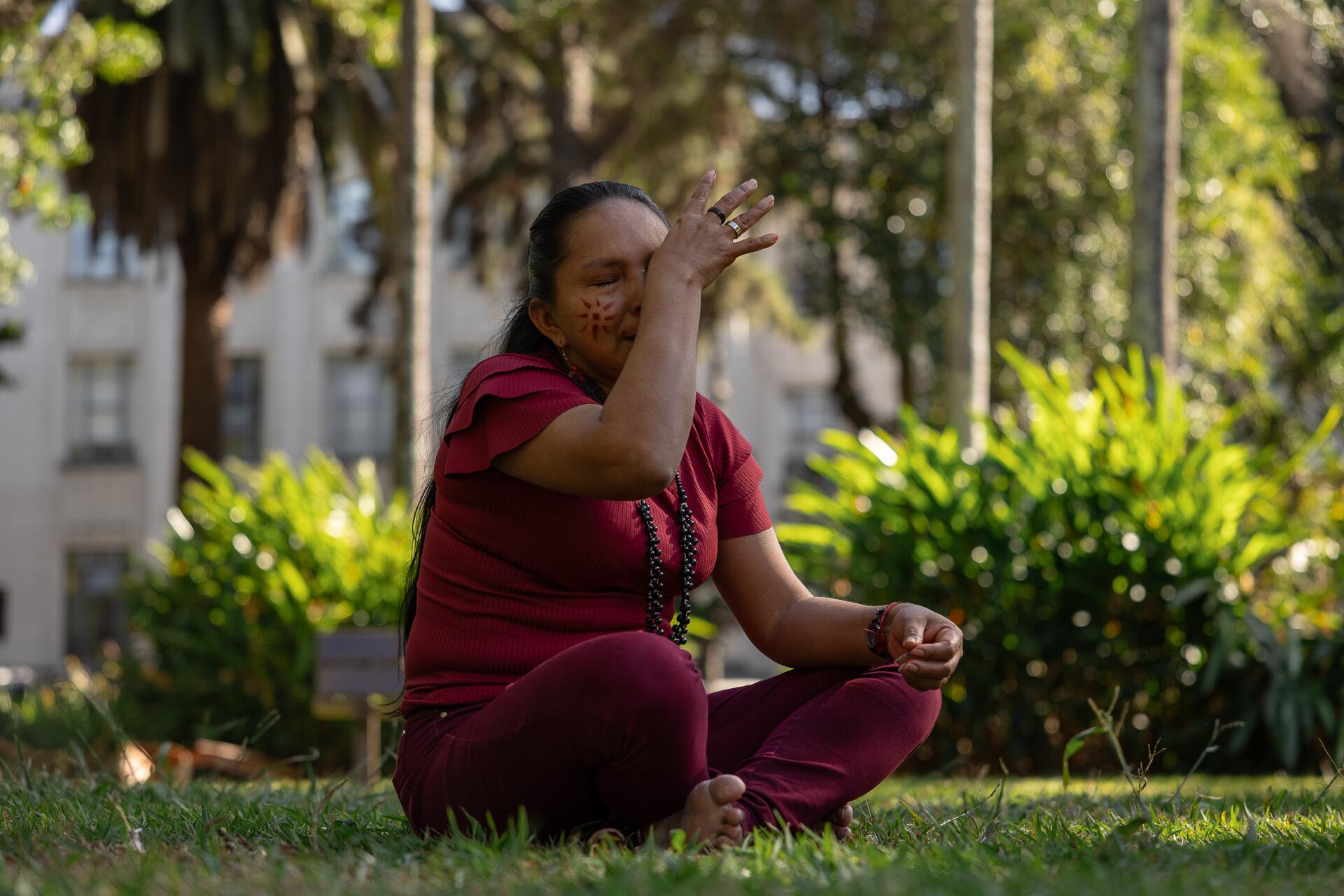
I was very warmly welcomed by my colleagues in the master’s and doctoral programs; I’m grateful for the words and moments I’ve lived as an Indigenous Baré woman. It is a constant process of adaptation and survival—behaviors, eating habits, clothing, and even the house where I would stay, a tiny little room. I never imagined going through this process. When I saw [the room], I felt short of breath; I wanted to cry. But I resigned myself. I’m going to make it.
I know I’m capable of mastering university life, where you share bathrooms, and the kitchen is filled with appliances neither I nor my family have ever seen (like an electric oven). The house I’m in doesn’t have a laundry room, but one day I found a creek in the neighborhood of Liberdade [she’s talking about a self-service laundry]. Every time an obstacle arises, I learn the essentials to staying alive and occupying space. I’m grateful to Professor José Miguel; Professors Bárbara Lourenço and Juliana Sangion with the Anthropology and Health Collective at USP’s Public Health School; to Verónica Goyzueta [cofounder of Sumaúma]; and other people who have contributed to my arrival in this totally different city.
May 30, 2023 – Heavy heart
Today I begin my new journey in life, where I will be the only author of my story, entering a territory that doesn’t belong to me, leaving my heart broken. My family won’t be with me on this academic journey. I’ve always had my family’s support. I got married really young, at 18, and became a mother at 19. I have three children—for an Indigenous woman this isn’t easy; it hurts a lot. Being so far away from my children mars my soul deeply as a mother. I know I’m heading to a space of new beginnings, of surmounting obstacles. That’s how it has gone. I traveled from Manaus to São Paulo with a heavy heart. I kept wondering what would happen to me. What am I going to eat? What am I going to do? Millions of questions.
When I arrived in the territory called São Paulo, Professor José Miguel and his family were waiting for me at the airport. For the first while, I went to stay at his home, with his family, and I was very warmly welcomed.
São Paulo was so rainy and cold when I got there. I received messages from my family, sisters, my husband, and other colleagues, asking how I was. I answered most often with the word “cold.” But I also replied, “I’m fine, thank God.” I had to find a way to protect myself from a phenomenon of nature that really couldn’t be questioned. The first night was awful. My toes kept cramping up, causing unbearable pain in my spine, making my ears and body ache. I had some warm clothes that Professor Flavia Melo gave me. I bought some other things at my neighbor’s thrift store—they were my protectors when I reached the territory called São Paulo.
May 31 – A new garden to tend
I was still at my professor’s house, with his family. That day I had a chance to take the subway to the university for the first time, with Professor Bárbara. It was very cold and rainy, and I thought, “What am I doing here? Is this really necessary? Will it serve any purpose?”
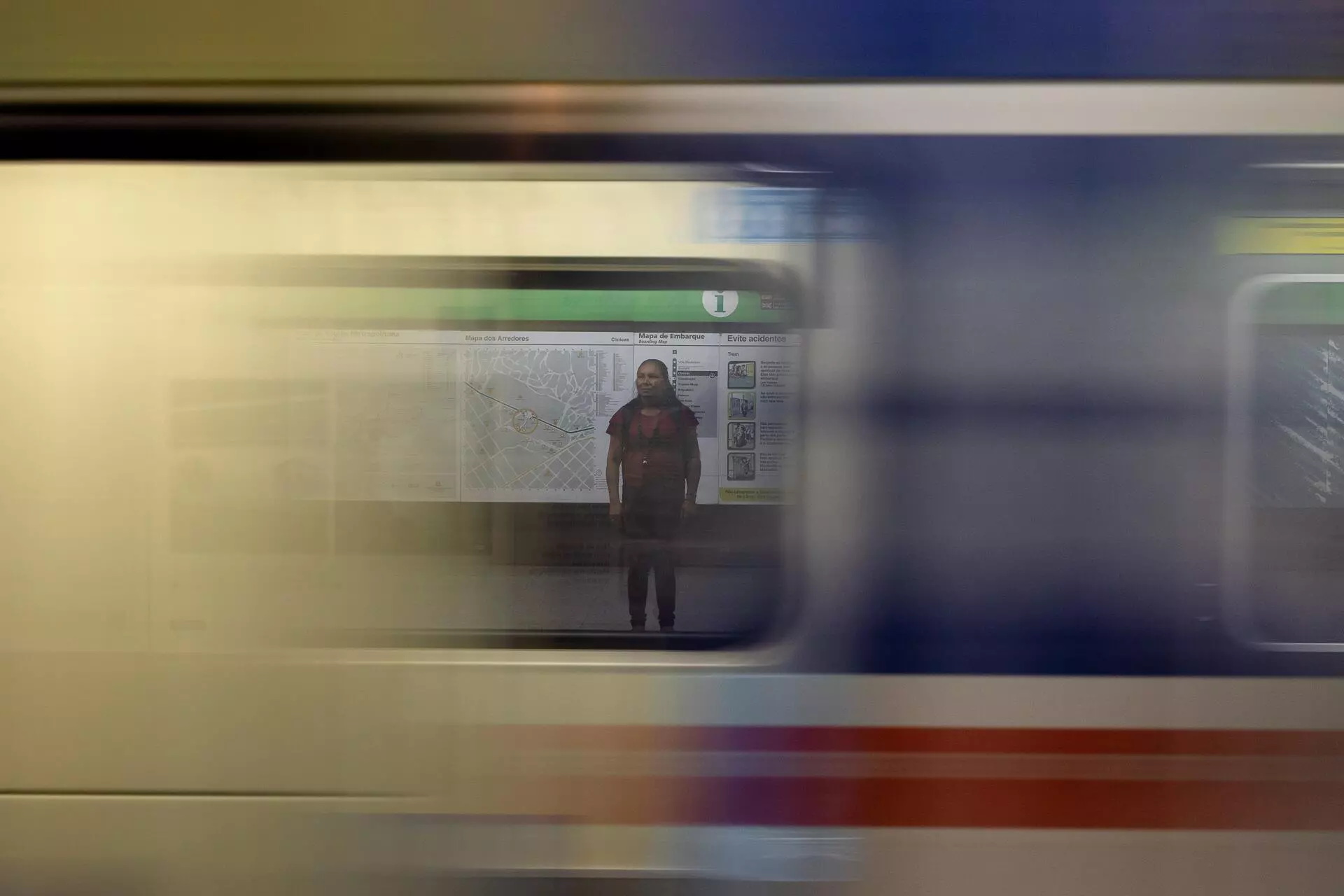
During my first days in São Paulo, it was very hard to see things I’d never imagined before. I’ve always been involved in activities through the Indigenous movement, where everything is always organized and laid out. During this trip, I laid everything out myself.
My first day on the subway was also a time for overcoming challenges. We descended to the depths of the earth, where life reigns like millions of ants, rushing back and forth. I thought to myself, “My God, another test I’m going through and another story to tell!” I kept wondering how they drilled those holes under the ground. And on top—cars, buses, people, buildings, and stores, all going on like nothing was happening deep below them. There are a million written things and ways of understanding where the subway lines go. It scares me just to think about it.
You experience two distinct worlds in São Paulo: the depths of the earth and the light of day in a city built in two geographic spaces, where the author of it is man.
When I arrived at the public health university, the building gave me chills. I wondered what was waiting for me inside. I was scared. [I asked myself:] Will I be able to learn everything inside this huge building, master it all? It made me nervous, yet with an urge to discover what was actually in there. I was bewildered and also needed to learn the terrain, as if it were a new garden I would have to learn to tend. And this is happening: right now I’m taking a class in collective health with people from law, economists, physical therapists, physicians… I never imagined I’d be in the midst of these people, with these backgrounds. Will I really learn? Is it really worth being here? I’m always wondering about that…
It was a very historic day for me. Being the first Indigenous woman of the Baré people, the daughter of farmers, with no academic training, in this space where many people come from upper-class families, financially well off. I didn’t even have $20 in my account; I ate what they offered me.
When I arrived at the department, I was introduced to some of the professors and to Professor José Miguel’s students. I was very warmly welcomed. They gave me personal care gifts, like bath towels, mugs, soap, sheets, and warm blankets. Little by little, I set things up for myself. Even so, worries reigned in my head because I knew the colleagues I had been introduced to wouldn’t always be there for me.
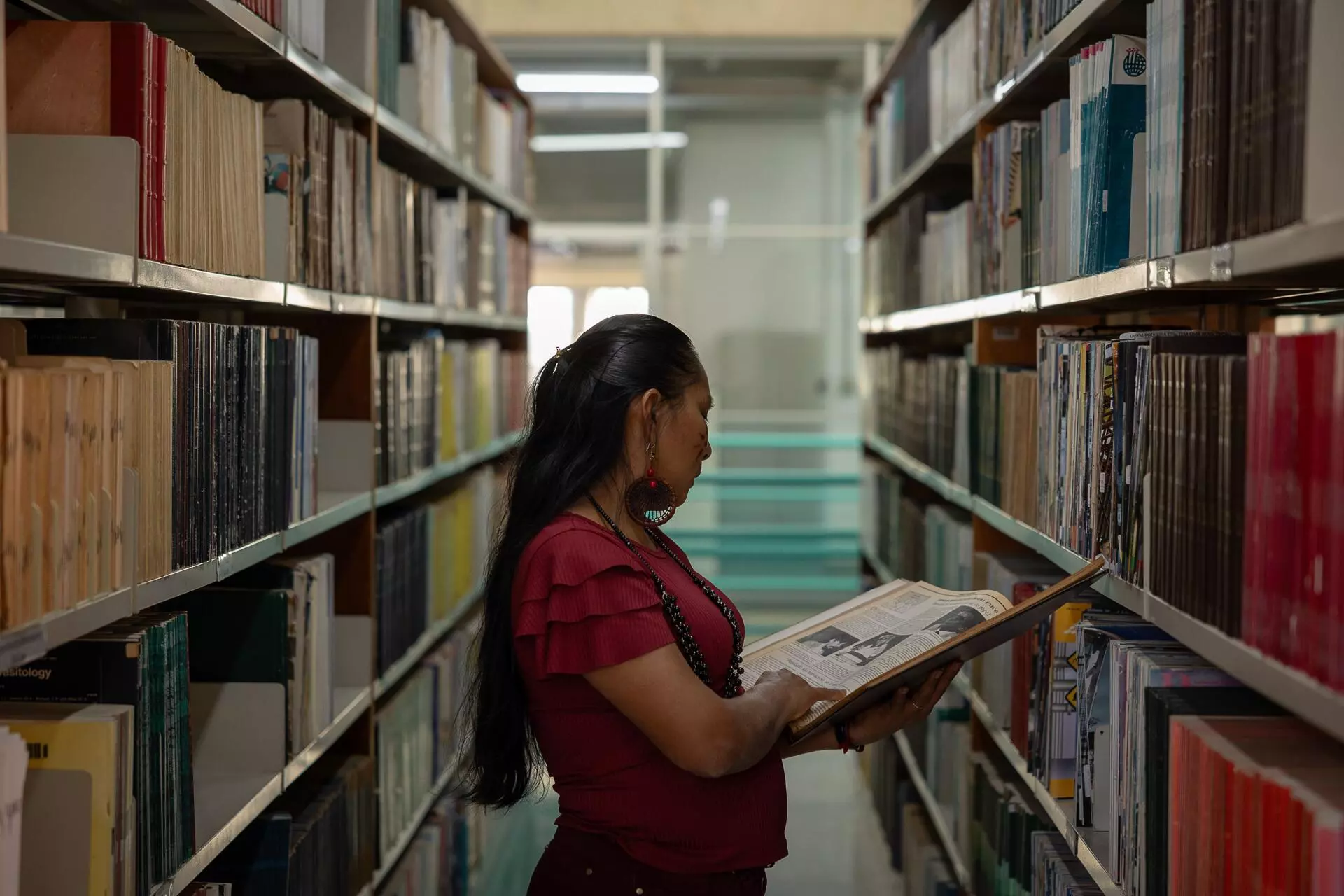
The university has passwords for various accesses and for occupying spaces; we’re made up of infinite numbers. Everything runs on electricity; without it, it seems like life has no meaning for people here.
In the afternoon, we went to get the key to my room. When we arrived, it was a shock, because I’d never lived in a mini bedroom. What could I do? I had to face reality. I got the key, and we went back to Professor Miguel’s house. We walked from the university. That helped me a lot; I need to know how to walk around the city and get to know some places. I’m not familiar with anything. I only know what I need to survive while I take up this academic journey.
June 1 – Protective shield
That day, I went to get my passport. Even at the university, my leadership side didn’t leave me because I believe it’s one of the tools that drives me to continue dreaming beyond the challenges we face in our territories. They are our protective shield. That’s why I agreed to take my first international trip, to speak on behalf of Brazil’s original peoples, on behalf of the collectivity and resistance. I’m grateful for the opportunities that arise in my life.
That same day I went to the administrative office at the university to pick up my life cards, which I use to eat and get around [student bus card and USP student ID card]. I call them my ‘life cards’ because if I don’t have them, I can’t eat or use anything at the university, like the library, cafeteria, printers. I need this card for everything. It has a number and tells who I am. It doesn’t even have my name. It has a number.
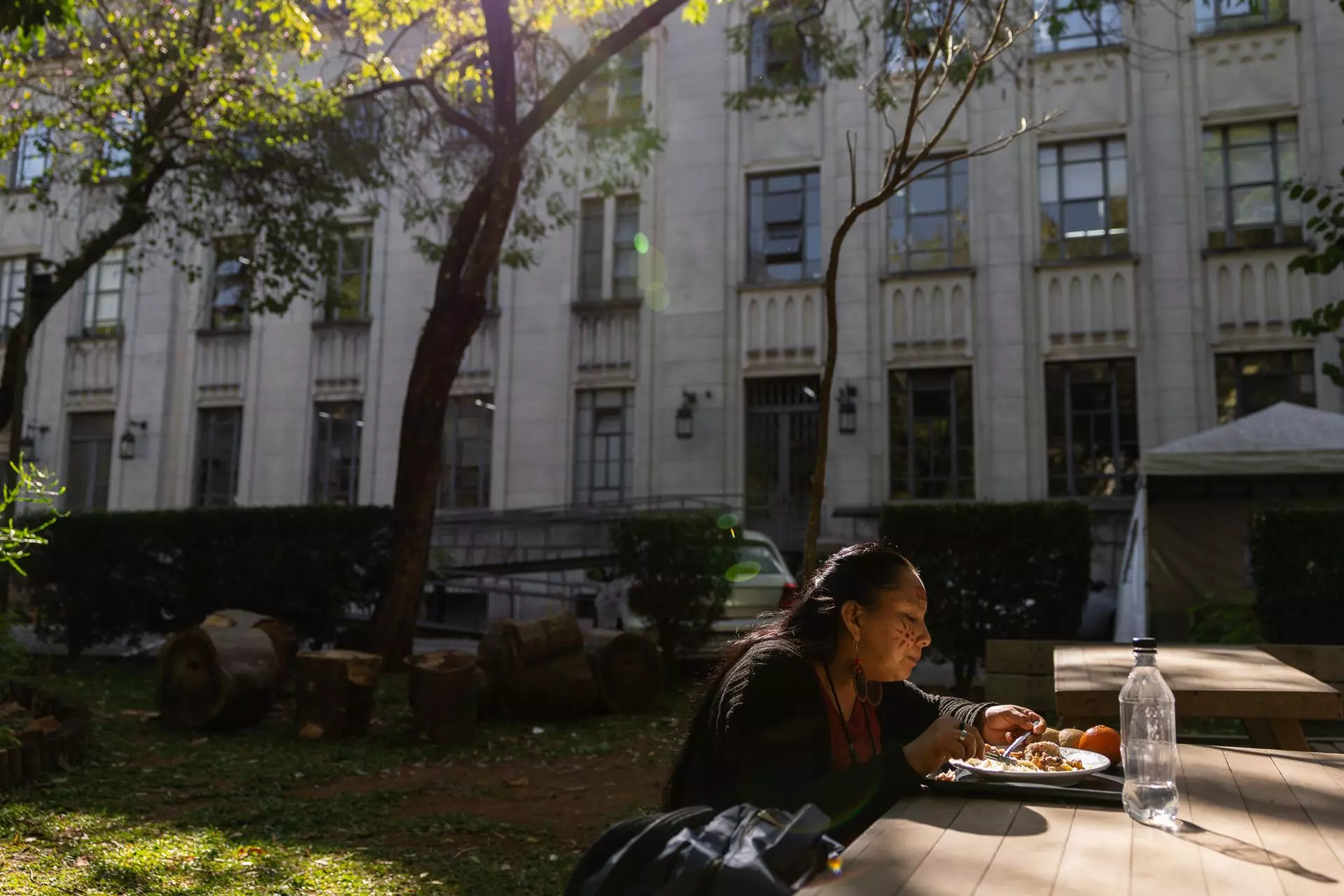
June 2 – Strategy for living
We went with the professor to 25 de Março street [a famous shopping street in downtown São Paulo], and we took the green, yellow, and blue subway lines. I kept thinking how someday I’ll walk around here without the professor; I’m going to learn all this and show that we, Indigenous women, can achieve things and we always have a desire to learn.
My family always sends me texts—this makes me feel safe to keep dreaming about better days for me and the collectivity. I know everything is difficult, but nothing is impossible.
25 de Março street was what I’d seen in my fourth-grade geography books: lots of people, an urban area, crowded with cars, people, stores. I saw what they show us at school to differentiate urban and rural. These were things I’d never seen before. There are too many people. I don’t even know how to explain that this really exists, outside books.
When I got to 25 de Março, I soon found some açaí seeds for sale. It was really good to find out where those things are, so I can do my art; for me this was really incredible. In the afternoon, I moved into my cold little room. I cried a lot that day, thinking to myself: my parents never raised me like this; look how I’m living now, my children far away, my family far away, my husband… Everyone is far away from me. If I get sick, who will take care of me? Look at this place, all so different.
When night fell, Verónica sent me a text. It made me happy because she said she had a warm coat: it was what I really needed to withstand the cold. She came to visit me, looked at my little room, and asked what else I wanted. I was embarrassed; I said I wanted some food and so we went to the supermarket. We bought everything I needed; I mentioned the house didn’t have a laundry room. She installed GloboPlay on my notebook so I could watch TV. I’m grateful for every offer of help, and so I make my way in this big world. I’m even putting cotton in my ears to protect me from the cold.
June 3 – Surviving in the midst of machines
I stayed in the little room while trying to adapt to the kitchen. It didn’t really work out, but I’m grateful to Julia Kaori, my colleague in the master’s program, for helping me face my fear of the electric stove.
I’m managing to survive in the midst of machines that do everything. I told Kaori that I hadn’t managed to cook anything since I arrived. We looked up on YouTube how to work the stove. Until you put a pan on top of it, the stove won’t heat up.
This is where I’m at, like I’m in a garden you tend to, so it won’t vanish. Everything I learn I try to put into practice. You learn from your mistakes.
June 4 – Tumultuous interculturality
I went over to Tamires Machado Moreira’s place. Tamires did research for her doctorate on midwives in my territory, in São Gabriel da Cachoeira; that’s how I learned about the public health university at USP. She’s an obstetrician and the closest person I know in São Paulo, she and Professor José Miguel. In 2019, I traveled with her around my territory.
I went to her home by myself, taking the subway, with heart in hand. I made it. I got off at Liberdade station. That day I found a market where you can wash clothes—that is, a laundry inside the market. There’s everything here, but you only have access if you have money.
Big cities are like that: everything is driven by money. Many people live on the streets; they’re called beggars. Some have a lot and others have nothing; it’s a very complex pyramid. While the community reigns in Indigenous territory and the fruits of nature multiply, here everything is manipulated and managed. If you have money and a job, you’re fine; but if you’re a student like me—and a mother—it’s real tough.
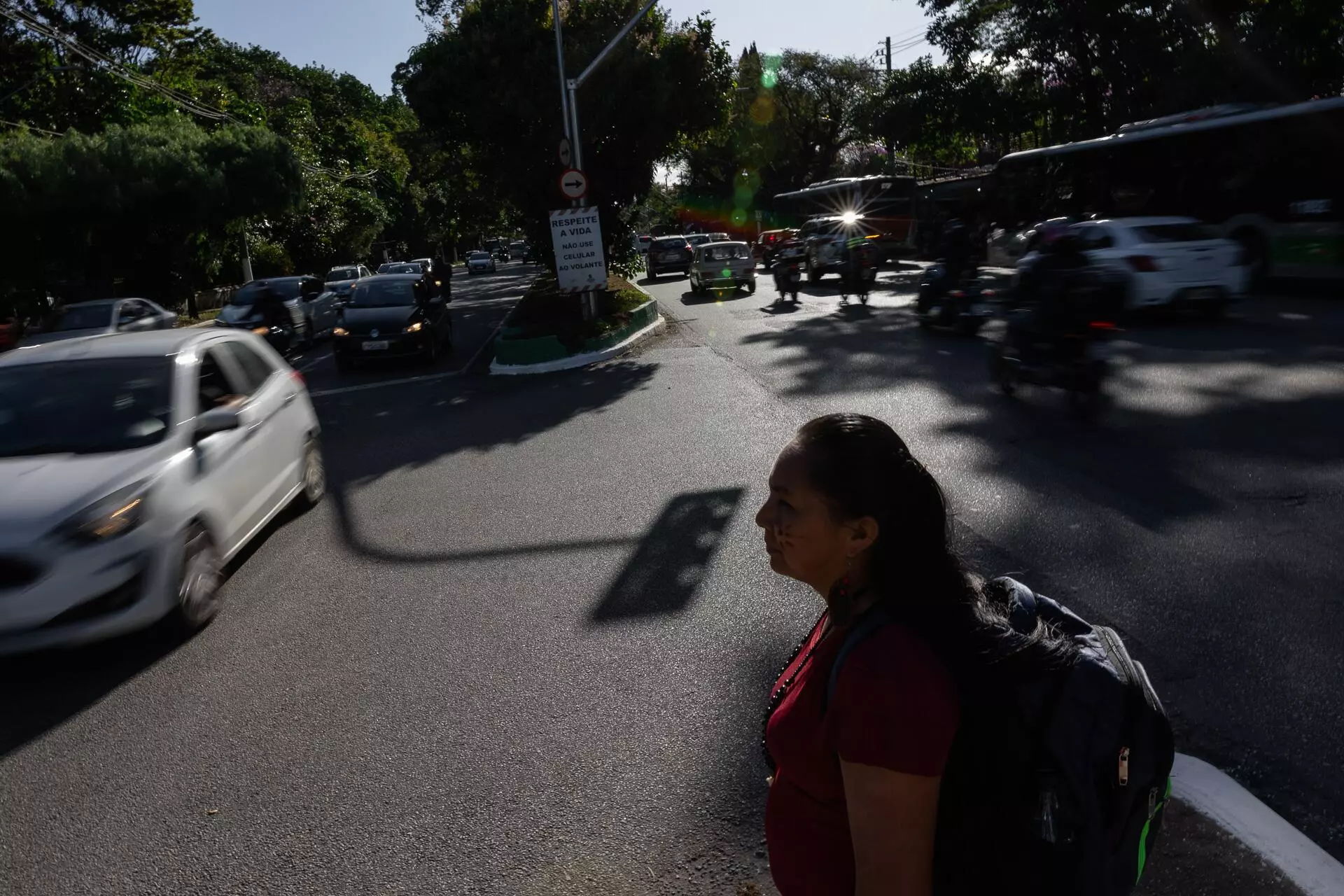
Everything I see here reminds me of my children. What would they say about this, here with me? I know that everything I’m seeing and feeling, nobody could tell better than me what this giant city really is all about. Within its unfamiliar interior, millions of buildings, millions of people, tumultuous interculturality, which goes unnoticed by the individuals who make it up.
For people here, it all seems natural. Are people reading about climate change? Do they only think about themselves here? Don’t they think about the fact that their food comes from the earth? That if they don’t have water, if there is no rain, if there is no land, what will they eat?
The only thing people are concerned about is this: I have my job, I go out, come back, and don’t think beyond these things. I don’t see why I should worry about whether it’s so cold, so hot, why there are floods. They are ants who work day and night and don’t know for whom. They say it’s for a queen.
That day I went to the movies for the first time. It was really good because every experience teaches me something… I’d never gone to the movies. It was very strange. The movie was spoken in English and translated into Portuguese. You had to read it. Watching it on that big screen, with that look, it scares you. I always wonder what life is like for white people. Movie theaters are really different from slides; it’s another way of understanding, of trying to be in a place. It feels like you’re in the middle of the movie, kind of like in a river, surrounded.
June 5-7 – Baskets of knowledge
I went to my first graduate course—a time for a great exchange of knowledge and learning. For me, it’s another care space that has opened up, a moment for reflection. I’m making it, bit by bit. I’ve already gone through several processes.
My husband, even far away, complaining about things, says: “You’ve spent a lot, people are helping you, stay there, you’ll make it.” I don’t know if he means it, but I try to believe he does.
I’m slowly learning what a Public Health School is. The academic world demands reading and the description of diverse forms of knowledge. I share baskets of knowledge from Rio Negro women, which hold an infinity of diversities, like medicinal plants and post-partum care. I’ve heard a lot of technical words; I’m learning new concepts in health. I know there is more and more learning here.
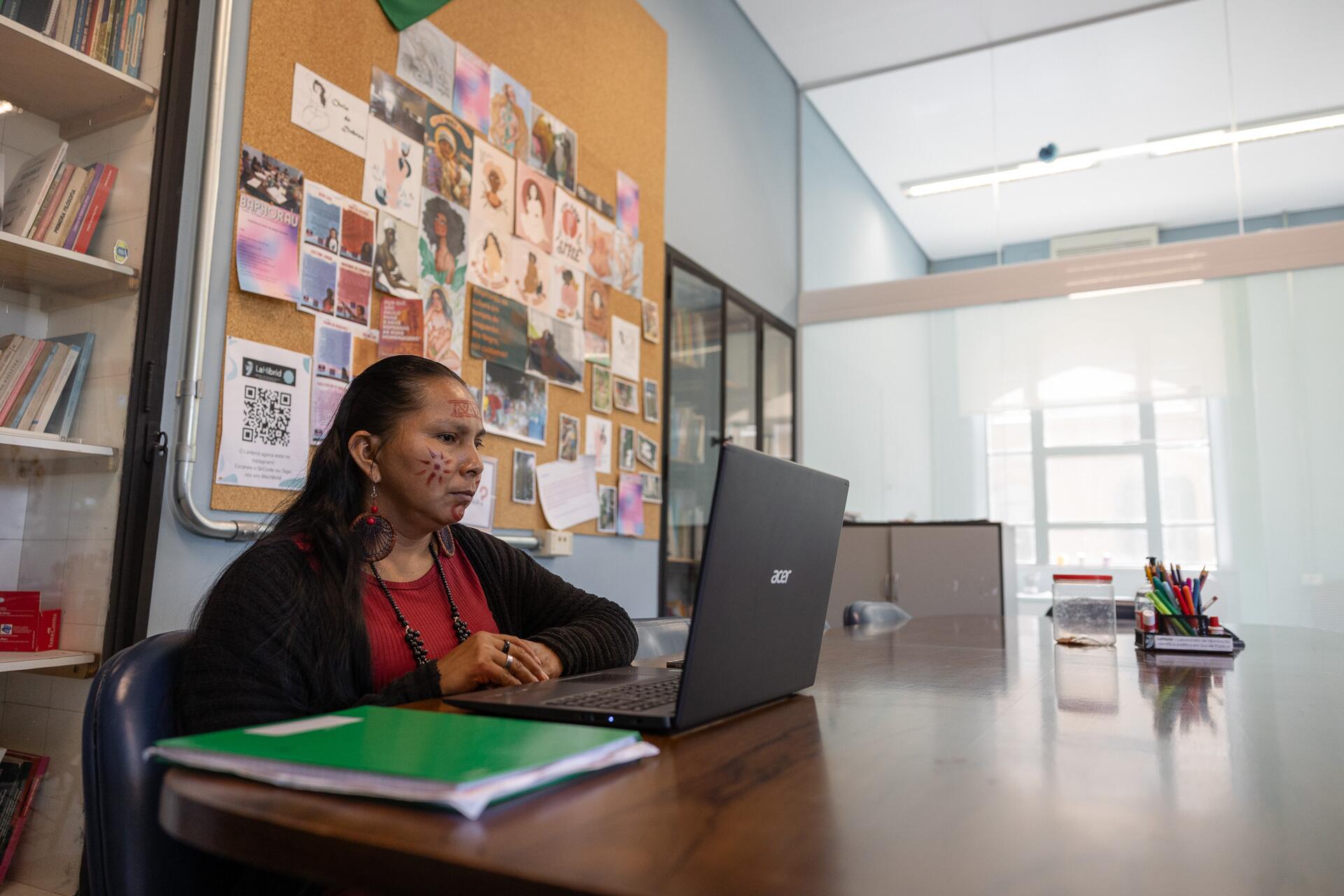
I met a relative [“relative” is a term applicable to anyone within the same Indigenous people], Sarlene Macuxi, from Roraima. She’s the first Indigenous woman doing a doctorate at USP, and I’m the first doing a master’s. We went to a book fair together. With each moment I’m like a child learning to take her first steps.
June 9-11 – Everything is at stake
We went to the Pinacoteca [São Paulo state art museum] to enjoy the last dance of Francineia Baniwa’s family—she’s a very strong Indigenous woman who is always ready to conquer life’s challenges. I know nothing is easy; it’s all different—eating habits, clothing, how people talk… Even more so for us Indigenous women. Everything is at stake, our territory, our families.
On this day, when I saw her father, brother, and son with her, I thought, she must be very happy because she has a part of her keeping her company. One day I’ll have someone from my family real close to me… I’d also like to have someone with whom I could share the moments I’m living through, to tell my children and grandchildren about every place I’ve been, everything I’ve eaten, every moment I’ve lived. I’m a nomadic woman in search of a better life and achievements, because the Indigenous context is machista and it’s hard to break the taboos of tradition. I was happy to see how the space Francineia has built is so important to her. It demands courage from the ancestors who are always with her.
June 12-18 – Me alone among millions
This week I did a bit of everything. I’ve been reading books, making crafts, and writing. This is what I do so my heart doesn’t feel like crying. I went to Avenida Paulista [major commercial avenue and cultural center in downtown São Paulo], alone, without anything to say—say what and to whom? Millions of people smiling, out and about, eating, and me alone there among those millions…
I’m making my way, crying in the midst of millions of people and thinking how I could be with my family, not seeing these crowds. That doesn’t do me any good. I know one day I’ll look back on this and say I made mistakes, but I learned alone. Just me and God. Only he knows where I’ve traveled, heart in hand, saying “Will I make it?” I need to learn to fly and walk on my own legs.
This week I went to the mall to get my passport; I’m making arrangements for a trip to Geneva. I had a number of exciting experiences. I’m writing this because I don’t have anyone with whom I can share all the moments I’ve been living through. A cell phone isn’t the same… Besides, I don’t want to worry anyone with the crazy stuff I’m going through, especially my family. My children and my husband are in the safest place in the world; they’re being looked after by my brothers, sisters, and brothers-in-law, by their father, by their grandparents.
If they ask questions over the cell phone, if I’m okay, if I’ve eaten, I always say yes, I’m not sick; I’m at the university. I never reply by saying I’m cold… I know one day they’ll remember me as an Indigenous woman and mother who always believed that studying can help us individually and collectively, and so I’ll continue to fight for better days.
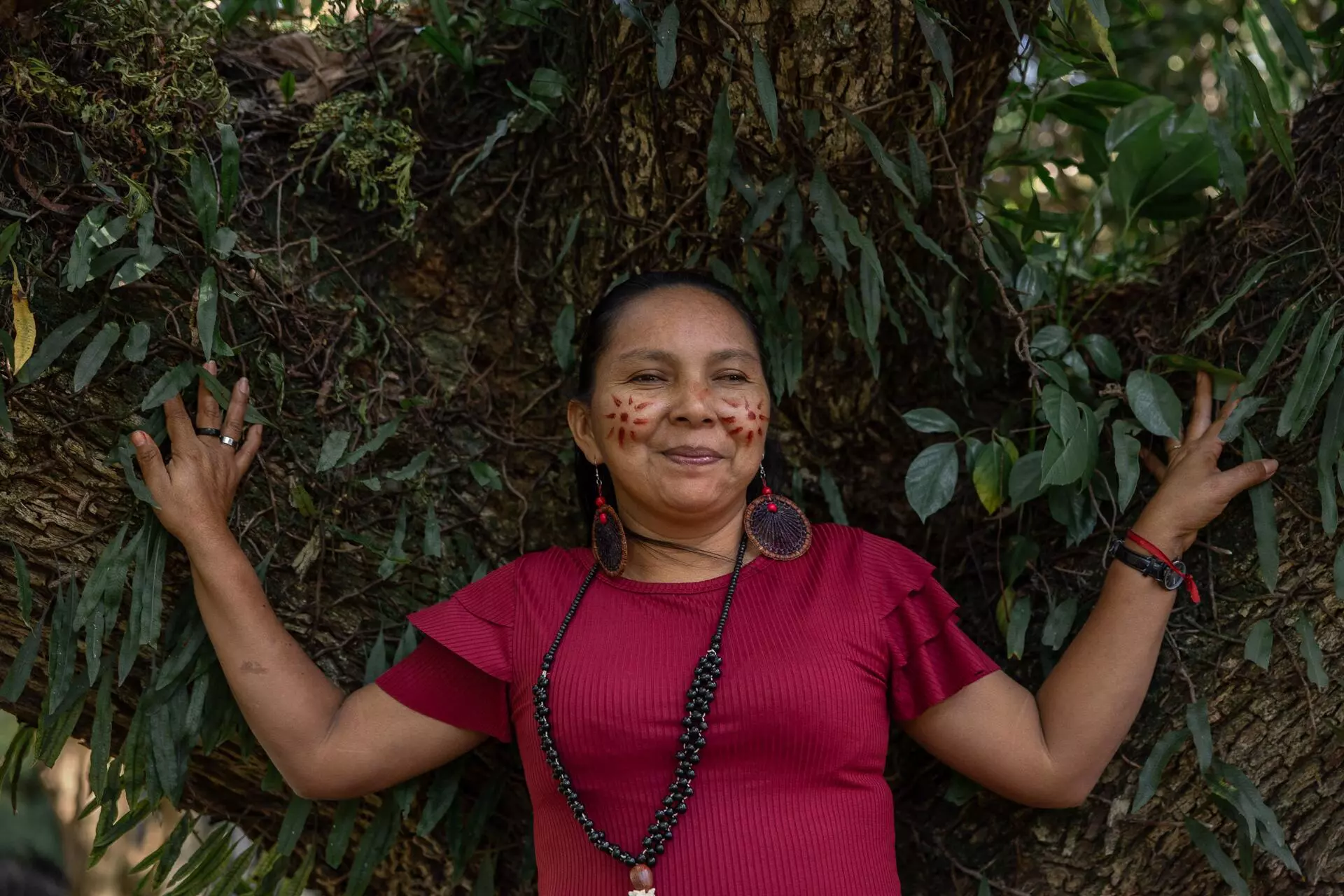
June 19-23 – Reborn along with the seeds
I went to Professor Bárbara’s house to wash my clothes. Then I went back to my little room on June 21 and planted my seeds at the university. I don’t know whether they’ll germinate because they’ve been out of the soil for so long.
On Thursday I went to the university garden, where I had the opportunity to meet a student who takes care of it. She told me I could plant the seeds I brought from Amazonas. I visited the small shed where they store gardening materials. When I got there, I took some soil and pots for planting. But when I went to look for water, I thought there’d be a hose. There’s an app that helps you turn on the water; I watched the girl, but simply no water came out. I grabbed some watering cans and went to get water where students wash their hands on the way into the cafeteria. So much bureaucracy for a university garden!
On June 30, I’ll have my first meeting with the professor who organizes this. Let’s see what she’s going to say. I just want to plant a seed for body care, another for making crafts, and another that’s for eating. That’s all. I hope it all works out, that they can be reborn together with me, and continue living in different worlds.
Spell check (Portuguese): Elvira Gago
Translation into Spanish: Meritxell Almarza
English translation: Diane Whitty
Photography editing: Lela Beltrão
Page setup: Érica Saboya
